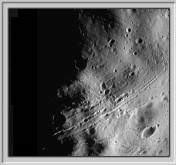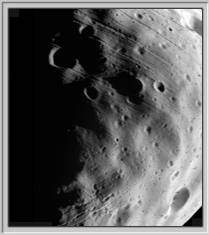Main page of the Phobos section here.
Viking has discovered another mystery in the most unexpected place - one of the two small Martian moons. Mariner 9's mapping of Phobos (12x14x17 miles or 20x23x28 kilometers) and Deimos (6x7x10 miles, or 10x12x16 kilometers) showed many craters, and left most investigators that they were merely rocky chunks that bore the scars of meteorite impacts. There was a puzzling feature on Phobos that a few analysts noticed but, without better data, could say little about.

A the limit of resolution were a few small crater pits that seemed to align in one or two chains. This was unusual, because crater chains on the moon were traditionally explained as volcanic pits - small eruption sites string along fracture lines. Yet Phobos apparently is too small to generate heat and conventional volcanic activity.

Viking's high resolution photos have revealed that the crater chains are real and part of an extensive system of parallel grooves, a few hundred yards wide (shown in Viking orbiter photo number 39B84). There may be a tendency for the grooves to lie parallel to the direction of the satellites orbital motion, although there appears to be several swarms with somewhat different orientations. Scientists are at a loss to explain them. Theories being discussed include: grooves left by much smaller satellite debris also orbiting Mars (though the grooves seem to follow contours of Phobos' surface to closely for this to be tenable); fractures radiating from an impact crater not yet recognized (perhaps on the side of Phobos still poorly photographed); or fractures created in the body of the Martian satellite when it was part of a hypothetical larger body and that it spawned both Martian moons, perhaps during a catastrophic impact.